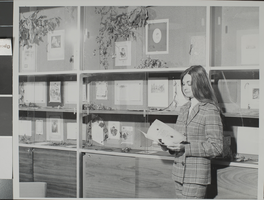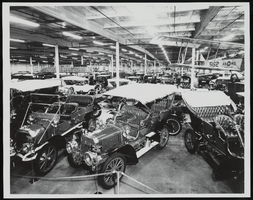Search the Special Collections and Archives Portal
Search Results

Photograph of Phyillis Durham in Special Collections, Las Vegas, September 1972
Date
Archival Collection
Description
Image
UNLV Libraries Single Item Accession Photograph Collection
Identifier
Abstract
The UNLV Libraries Single Item Accession Photograph Collection (approximately 1869-1999) contains photographs, postcards, negatives, and slides primarily pertaining to Southern Nevada, with a focus on Las Vegas, Nevada, collected by the University of Nevada, Las Vegas University Libraries, Special Collections and Archives. The collection primarily includes images of early Las Vegas, hotels and casinos along Fremont Street and the Strip, railroad infrastructure, local businesses, and residential neighborhoods. Also included are images of Hoover (Boulder) Dam's construction, MX Missile testing, Nevada mining camps, and the natural desert environment. Other images depict towns throughout Nevada including Boulder City, Henderson, Reno, Luning, Tonopah, Goodsprings, Delmar, Beatty, Panaca, Overton, Caliente, Logandale, and Aurora.
Archival Collection
Las Vegas Casino and Hotel Advertisement Clippings Collection
Identifier
Abstract
The Las Vegas Casino and Hotel Advertisement Clippings Collection (1986-1999) is an artificial collection comprised of advertisements and clippings of various Las Vegas, Nevada hotels and casinos. The bulk of the advertisements are from the
Archival Collection

William Harrah's automobile collection: photographic print
Date
Description
Image
UNLV Libraries Collection of Gambling Related Sheet Music
Identifier
Abstract
The UNLV Libraries Collection of Gambling Related Sheet Music (1890-1987) consists of primarily early 20th century American gambling-related sheet music. This collection is most noteworthy for the covers' bright and colorful imagery, including white gentlemen playing cards, imagery from card and related games, and some with offensive stereotypes and caricatures of African Americans. The material was created by a wide range of designers, composers, and publishers from various places, including New York, New York; Chicago, Illinois; St. Louis, Missouri; Detroit, Michigan; and Williamsport, Pennsylvania. This collection contains illustrations which depict Black and Asian individuals in racist caricatures, photographs of white individuals wearing blackface, and some song titles include derogatory language or racial slurs.
Archival Collection
Doughty collection, genealogy research, undated
Level of Description
Archival Collection
Collection Name: Nan Doughty Family Collection
Box/Folder: Box 01
Archival Component
Bills, invoices and collections, 1967-1992
Level of Description
Archival Collection
Collection Name: Ruby Duncan Collection on Operation Life
Box/Folder: Box 1
Archival Component
Western Casino Collectables: booklets, 1992
Level of Description
Archival Collection
Collection Name: UNLV Libraries Collection of Gaming Research Files
Box/Folder: Box 11
Archival Component
Casino Collectables Swap Meet, 1989
Level of Description
Archival Collection
Collection Name: UNLV Libraries Collection of Regional History Files
Box/Folder: Box 07
Archival Component
Traccia "The Balboa Collection", 1990s-2000s
Level of Description
Archival Collection
Collection Name: Las Vegas Real Estate Brochures Collection
Box/Folder: Box 07
Archival Component
